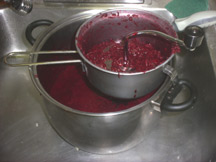
Below is a description of dozens of varieties of on the market in the United States and Britain to help you choose the apple that you will like best! There are new varieties appearing on the market every year and some the go away. For example, there is a new cross between Honeycrisp and Fuji, called Evercrisp. Apple growers simply prune their existing apple trees down to a strong trunt, then graft cutting of the new variety onto it. This way they can be producing the new paples in a couple of years! Meanwhile, there are heirloom varieties that have been around for hundreds of years. New or old, the big difference is which apple meets your neeeds in taste or flavor profile, , storing ability, sweetness, and other properties like resisting browning when cut.
Scroll down this page for a table of dozens of apple varieties including photos and their characteristics and best uses. This page has tips about harvesting and storing apples. And if you bring home some apples and want to make applesauce, apple butter, apple juice, apple pie, apple cobbler, apple crisp, even apple cider, just click the links for each to follow directions and recipes or see this page see this page for a master list of simple, reliable, illustrated canning, freezing or preserving directions. There are plenty of other related resources, such as this list of local regional and apple festivals - click on the resources dropdown above.
If you have questions or feedback, please let me know!
Apple varieties Alphabetical Chart - which apple to pick and why!
2025 looks to have apples ripening on their normal schedule. There have been few late frosts in the main apple growing regions, rain and temperatures have been good, so the year is shaping up well for a good apple crop. It's too early for prices, but I expect most areas to see $14 to $30 a bushel, depending on variety! Scroll down the page to see the chart, or click here for a PDF print version. And for an explanation of why apple slices turn brown and how to stop it, see this page! To see how to properly store apples for the winter, see this page! Finally, if you have an apple tree and want to know what variety it is, see this page.
Alphabetical List of American Apple Varieties and Detailed Characteristics
Click here for a PDF printable version of this table
If you are looking for the summary table, click here.
 Ambrosia
Ambrosia- Sweet, crisp, aromatic flavor reminiscent of pear and low acidity.
- Mostly red coloration, with yellow patches.
- Flesh is cream-colored, firm meat
- Medium to large in size
- Developed in British Columbia in the early 1990s.
- Believed to be a cross of a Jonagold and Golden Delicious.
- Ripens mid to late season
 Akane
Akane
- Early mid-season
- also known as 'Tokyo Rose', 'Tohoku No.3' and 'Prime Red'
- Pronounced 'ah-kah-nay,'
- firm, crisp apple
- ripens in early to mid September
 Ashmead
Kernal
Ashmead
Kernal
- A small heirloom apple, covered with a thick russet,
- often found in Virginia, originated in England around 1700 and was brought to the United States much later.
- Very sweet and acidic
- Ripens from late September into October
 Arkansas
Black
Arkansas
Black
- A medium to large apple
- dark purple to almost black
- Very, very hard texture and an excellent keeper.
- Almost too hard-textured at harvest. Best after some storage time.
- Great for baking; and terrible for applesauce
- A Winesap type.
- Late season
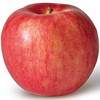 Autumn
Crisp
Autumn
Crisp
- Sweet tart flavor
- flesh resists browning
- high in Vitamin C
- late season
- Good for applesauce
 Baldwin
Baldwin
- good quality large red apple
- An old variety, subject to cold injury in the winter
- late mid-season
- medium sweet
 Bevan's
Favorite
Bevan's
Favorite
- Very early season
- Mostly used for cooking
- Old variety, from 1859
 Black Twig
Black Twig
- a Tennessee apple that was introduced about 1830
- popular dessert apple, tart apple; good for fresh eating and high tannic acid which adds body to cider.
- mid to late October
- medium to large size with varying color, usually green to yellow skin that is streaked and flushed red to burgundy and yellow, firm flesh
- excellent keeping apple, store in the refrigerator for best flavor
 Blondee
Blondee
- Smooth yellow skin with slight russeting at the stem and scattered tan-colored pores
- Sweet-tart flavor,
- Crisp, juicy white flesh.
- Excellent for eating fresh and also a good cooking apple
 Blushing Golden
Blushing Golden
- Medium-sized waxy coated modern yellow apple with a pink blush
- Jonathan/Golden Delicious cross.
- Firm flesh with flavor like Golden Delicious, but tarter.
- Keeps well
- Late season
 Braeburn
Braeburn
- Rich red color with white flesh
- Sweet
- Best for eating
- Late season
 Cameo
Cameo
- A large, round sub-acid apple
- Red blush stripe over yellow.
- Late ripening
- Sweet/tart, good all-purpose use apple
 CandyCrisp
CandyCrisp
- from New York State.
- Early October
- very sweet, low acid, very juicy, firm yellow-skinned apple
- best eaten fresh, Good for eating, baking, sauce, and juice.
- can store for up to four months
 Cortland
Cortland
- A Ben Davis/McIntosh cross
- large flat, dull red apple with a purple hue and soft, white flesh
- Less aromatic than McIntosh
- Good keeper.
- Very good in salads.
- Mid season
 Cosmic Crisp(The variety has its own
Cosmic Crisp website)
Cosmic Crisp(The variety has its own
Cosmic Crisp website)
- Breeding began in 1997 at the Washington State University (WSU) Tree Fruit Research and Extension Center in Wenatchee, Washington,
- Cosmic Crisp is a cross between Honeycrisp and Enterprise apples, intended to have the texture and juiciness of the Honeycrisp, and the late-ripening behavior and long storage of the Enterprise.
- Storage is very good,
- Dark red skin, dense firm flesh
- Ripens at the same time as Red Delicious
- First available to consumers in 2019,
- High in both sugar and acidity, making it as good overall or better than Red Delicious, Gala and Fuji
 Cox's
Orange Pippin
Cox's
Orange Pippin
- Popular in English markets.
- Medium sized, golden yellow skin, with brownish orange
- often russeted.
- Flesh tender, crisp, semi-tart
- early
 Crimson Crisp
Crimson Crisp
- Tart and Juicy
- Fresh Eating
- Disease Resistant
- mid to Late Season
 Crispin/Mutsu *
Crispin/Mutsu *
- Light green to yellowish white
- Sweet, rich, full flavor, very juicy and super crisp.
- Firm, dense texture
- Best for: eating fresh
- Mid - late season
 Earligold
Earligold
- medium to large, round-conical apple
- early season
- tart but good for an early apple.
- Stores reasonably well
.
 Empire*
Empire*
- A McIntosh type apple
- Long shelf life
- Aromatic and crisp with creamy white juicy flesh.
- Flesh does not brown quickly when sliced
- Tasty blend of sweet and tart
- Best for: eating fresh and baking
- Early - Mid season
 Enterprise
Enterprise
- Large, red apple
- Disease resistant
- Ripens 3 weeks after red delicious
- Stores well, flavor improves in storage
 Evercrisp
Evercrisp
- a cross between Honeycrisp and Fuji
- sweet, crisp, firm and dense just like its parent cultivar Honeycrisp.
- late-season apple, ripening in mid-October and harvested in October to November depending on the region.
- skin is blushed rosey red over a cream background.
- stores well
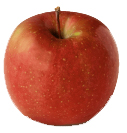 Fuji
Fuji
- Very sweet, aromatic flavor
- Yellow-green with red highlights
- Originated in Japan.
- Best for: eating, salads, best applesauce apple
- Late season
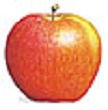 Gala
Gala
- Developed in New Zealand.
- Sweet, aromatic flavor
- Best for: eating, salad, best applesauce apple
- medium to smaller in size with a distinctive red and yellow striped heart-shaped appearance.
- Early to mid season
 Ginger
Gold
Ginger
Gold
- Very slow to turn brown, so it's a great choice for apple slices.
- Early yellow apple that's sweet and mildly tart.
- Best for: eating, sauce, salad
- Early ripening
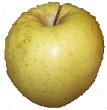 Golden
Delicious
Golden
Delicious
- Firm white flesh which retains its shape
- Rich mild flavor when baked or cooked.
- Tender skin
- Stays white longer when cut;
- Best for: salads, blend in applesauce
- Early season
 Goldrush
Goldrush
- late season, mid to late October
- flavor is mild, sweet, like Golden Delicious
- dessert apple
- specifically developed for scab-resistance and powdery mildew. makes it good for organic gardens
- tart, tangy flavor that sweetens with age.
- Good for fresh eating or in pies and crisps.
 Grimes
Golden
Grimes
Golden
- Firm white flesh which retains its shape
- Rich mild flavor when baked or cooked.
- Tender skin, with a "grimy mottled surface"; (but there IS also Mr. Thomas Grimes, who developed the variety, see Wikipedia)
- Stays white longer when cut;
- Best for: salads, blend in applesauce
- Early season
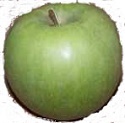 Granny Smith
Granny Smith- Very tart
- Bright green appearance, crisp bite and tart apple flavor.
- Best for: people who like tart apples rather than sweet ones :-)
- Mid to late season
- Firm crisp, white flesh
- Not good for applesauce unless you add sugar (or like a very tart applesauce)
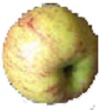 Gravenstein
Gravenstein
- Greenish-yellow with a lumpy appearance
- Tart flavor
- A good, all-purpose apple,
- Good for applesauce and pies.
- originated in the 17th century or earlier.
- Picked in July and August and
- Does not store well,
 Hokuto
Hokuto
- A Mutsu/Fuji cross
- crisp texture of Fuji,
- large size and shape of Mutsu,
- sweet flavors
- late mid-season
 Honeycrisp
Honeycrisp
- Introduced in Minnesota
- Very sweet and aromatic
- Great for juice, as it is a very juicy apple
- Best for: Eating, pies, baking
- Mid season
 Idared
Idared
- Crisp and juicy with a sweet tart flavor.
- Great for pies and fresh eating.
- Late season
- developed at the University of Idaho Agricultural Experiment Station in 1942
- it is a cross between Jonathan and Wagener
- white flesh with a firm body,
- Excellent for apple sauces, pies, and cakes.
- harvested at the end of September to the middle of October.
- EXCELLENT keeper, storing apple remains good until the end of January,
 Jazz
Jazz
- Cross between Royal Gala and Braeburn, developed in Australia
- Very sweet, more flavor than Gala
- Vewry good fresh eating and applesauce, apple butter
- A "Club" variety, meaning licensed with limited commercial growing, first appeared on the shelves in 2004.
- late ripening
 Jersey
Mac
Jersey
Mac
- early season (August)
- medium sized red apple with yellow/green splashes.
- Flesh is crisp and juicy with a tart flavor.
- It is an excellent for eating fresh, apple sauce,
 Jonathan
Jonathan
- One of the first red apples of the fall
- Sweet-tart taste with firm texture
- Light red stripes over yellow or deep redd
- Best for: eating and cooking
- Early season
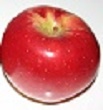 Jonalicious
Jonalicious
- Flavor like Jonathan but a little less tart and darker red skin.
- Larger, crisper, and juicier than Jonathan, and a better keeper.
- Slightly sour/acid balance.
- early midseason
 Jonamac
Jonamac
- A medium-sized Jonathan/McIntosh cross
- Sour flavored, aromatic and tender fleshed like McIntosh.
- Early season, a few days prior to McIntosh.
- Poor keeper.
Jonagold
*
- A cross of Jonathan and Golden Delicious.
- Best for: eating, sauce, pies, salad, baking
- Mid season
- A sweet/tart flavor
 Jubilee
Jubilee
- Best for: eating, sauce, pies, salad
- Mid season
- developed in British Columbia
- It is a cross between McIntosh and Grimes Golden.
- flavor is sweet, but is only crispy when just picked.
 Keepsake
Keepsake
- Best for: baking, sauces or eating raw.
- Small apple with a red outer skin and a cream colored fine textured flesh.
- very sweet flavor with a high sugar content
 Liberty
Liberty
- A highly disease-resistant introduction from Geneva New York.
- Liberty has superior dessert quality, similar to one of its parents, Macoun
- Best for: eating, sauce, salad
- flavor improves in storage
- late season
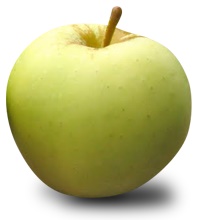 Lodi
Lodi
- Very early apple
- yellow
- also called Yellow Transparent
- hybrid of the 'Yellow Transparent' and 'Montgomery Sweet'
- originally from the New York Agricultural Experiment Station in 1924
- commonly grown in the Southern US
 Macoun
Macoun
- Named after a famous fruit grower in Canada
- Best for: eating, sauce, salad
- Very good, sweet, all-around apple
- cross between the 'McIntosh' and 'Jersey Black' cultivars.
- developed at the New York State Agricultural Experiment Station in Geneva,
- first introduced in 1923,
McIntosh
*
- Popular in America since 1811
- Best for: eating, sauce, salad, good as part of a blend for applesauce
- Sweet, tart, mild flavor
- It is, the national apple of Canada.
- red and green skin, tender white flesh
- Ripens in late September.
 Melrose
Melrose
- The official apple of Ohio
- Similar to a Jonathan but sweeter.
- Good for pies: the slices hold together in pies
- Keeps well
 Mutsu
Mutsu
- Lousy name, but a great apple
- It is sweet and crisp
- It is similar to Golden Delicious. but keeps a little bit better
- Best for eating fresh and it makes a great applesauce
 Northern
Spy
Northern
Spy
- Large, high quality fruit commonly used for desserts and pies, as well as juice and cider.
- Green base color, flushed with red stripes
- Good for storage, Mid-late season
- Originated in East Bloomfield, New York in about 1800
- Juicy, crisp and mildly sweet white flesh with a rich, aromatic subacid flavor, tarter than most popular varieties, noted for high vitamin C content.
- Flesh is harder/crunchier than most, with a thin skin.
 Opal
Opal
- mid to late October
- Does not brown when sliced (see this page for more info)
- first U.S. apple variety to be verified by the Non-GMO Project
- cross of 'Golden Delicious' with 'Topaz'
- naturally low in polyphenol oxidase making it resistant to browning
 PaulaRed
PaulaRed
- A tart apple
- bright red with some yellow and tan spots; the skin often has a dusty sheen with light to creamy flesh.
- Good for eating, in pies and sauces.
- Paulared arose as a seedling next to an orchard of 'McIntosh' trees
- ripens late in the summer
- becomes extremely soft when cooked, which suits them to some dishes (applesauce) and not others (pies).
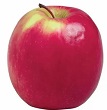 Pink
Lady
Pink
Lady
- Rich red/pink color with white flesh
- Very sweet and crisp
- Best for eating and makes a naturally sweet, smooth applesauce and it is good in salads and pies.
- A cross between a Golden Delicious and a Lady William.
- Late season
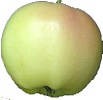 Pristine
Pristine
- Very early yellow apple
- Very sweet and juicy,
- bruises easily, not a good keeper
- the tree is known for its resistance to apple scab, but is susceptible to cedar-apple rust
 Red
Delicious
Red
Delicious
- WAS the most popular apple variety in the world! for decades (now being replaced by Fuji and Gala)
- Best for: eating, salad, very good as a base apple for applesauce
- Thin bright red skin with a mildly flavored fine-grained white flesh.
- Bruises easily and does not keep well.
- Early to mid season
- There are many, many varieties of red delicious, so there is a range of properties. Not all red delicious are the same!
 Redfree
Redfree
- early season, ripening around mid-August.
- Firm and crunchy flesh
- Can be stored up to 2 months without loss of quality or firmness.
- early-season apple
- The flesh is light cream. medium grained
Rome
- Best for: baking and cooking - but not applesauce - not sweet enough, and it has a fairly bland flavor
- Very smooth red apple with a slightly juicy flesh.
- Very hard flesh
- Mid to late season
 RubyFrost
RubyFrost
- tart, all around apple
- can be compared to Empire and Granny Smith.
- stores well,
- Late season, ripens later in the fall
 Sansa
Sansa
- Sweet
- Early season
- Good for Fresh Eating
- Not a great keeper
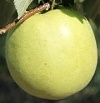 Shizuka
Shizuka
- Mid season
- great for salads, eating fresh or juicing
- Fruit is juicy, firm with and it's slow to brown when cut
- A sister to Mutsu/Golden Delicious and Indo apples developed in Japan, with milder flavor.
- Sweeter with less acid than Mutsu, but an excellent flavor and lack of acidity
 Snowsweet
Snowsweet
- from the University of Minnesota, released in 2006
- sweet taste, with a slight tart balance and rich overtones.
- white flesh is very slow to oxidize and turn brown after cutting.
- fresh eating, snack trays, salads, sauces
- Late, approximately 2 weeks after Honeycrisp
 Snapdragon
Snapdragon
- Newer variety, derived from Honeycrisp so it is very crisp and sweet
- Spicy-sweet flavor
- Long shelf life.
- crispy apple has a juicy, sweet flavor
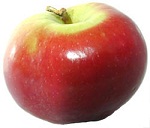 Spartan
Spartan
- A cross between the McIntosh and Pippin apples.
- Good all-purpose apple.
- medium size and has a bright red blush, but can have background patches of greens and yellows.
- introduced in 1936 from the Federal Agriculture Research Station in Summerland, British Columbia, now known as the Pacific Agri-Food Research Centre
- a small sweet apple, like a McIntosh"
- bright crimson skin and very bright white flesh
 Stayman
Stayman
- Juicy, cream-colored to yellowish flesh with a tart wine-like flavor.
- crisp crunch flesh
- Good storing apple, bruise resistant, dull red coat.
- Best for: Cooking, pies and cider
- mid-season, Early September
 Stayman-Winesap
Stayman-Winesap
- Juicy, cream-colored to yellowish flesh with a tart wine-like flavor.
- Stayman-Winesap is a cross between a Stayman apple and a Winesap apple.
- Exceptional eating quality.
- crisp crunch flesh
- Good storing apple, bruise resistant, dull red coat.
- Best for: Fresh, cooking, pies and cider
- late season, mid to late October
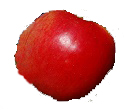 Strawberry
Strawberry
- A crunchy, juicy apple
- a red striped exterior with slight yellow blush
- sweet-tart flavor.
- Antique variety, originates from Chenango, New York, circa 1854.
 Summer Banana
Summer Banana
- Mid-August
- A sweet apple for eating or making fried apple pies.
- Old variety from South Carolina in the 1800s
- When fully ripe it has the faint smell of banana.
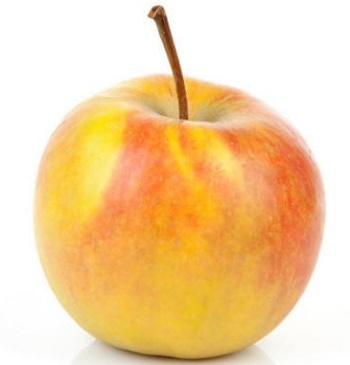 Suncrisp
Suncrisp
- A hard tart, long keeping apple.
- Red over orange color; Golden Delicious-type
- Ripens late in the season
- Best for Baking, storing
- Formerly known as NJ55, SunCrisp was developed at Rutgers University
- Cross of Golden Delicious, Cortland, and Cox's Orange Pippin apples.
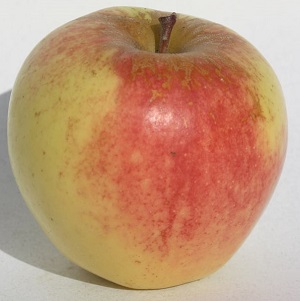 Sundance
Sundance
- Sweet, tart yellow apple with reddish highlights
- very firm, very crisp and breaking flesh.
- Late season
- Good for eating fresh, applesauce
- cross between Golden Delicious and 1050 NJ 1,
- released for sale in 2004
 SweeTango
SweeTango
- Similar to Honeycrisp
- Ripens mid August - September
- Developed at University of Minnesota
- Tightly licensed
 Ultra Gold
Ultra Gold
- mid to late September
- Yellow, sometimes flushed with light red blush;
- crisp, juicy, sweet
- A long-lasting,
- all-purpose apple good for snacking and cooking.
- Excellent for sauce, pies, and juice when mixed with another variety
 Virginia Gold
Virginia Gold
- cross of Albemarle Pippin and Golden Delicious around 1976 at Virginia Tech
- mid-season
- Bright yellow when ripe
- has a pink blush and a smooth, clear skin,
- flesh is crisp, juicy
- mildly subacid flavor characteristic of the Pippin.
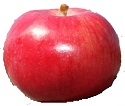 Vista Belle
Vista Belle
- Developed at Rutgers University back in the 1950s,
- very early, July
- Bright red when ripe
- does NOT store well
- crisp, tart and remarkably rich-flavored apple
 Wild Crisp
Wild Crisp
- New (2019) Cross between Honeycrisp and Cripps Pink (AKA Pink Lady)
- Juicy crunch of Honeycrisp combined with the intricate flavor of Cripps Pink
- Very juicy with sweet, balanced flavor also very crunchy
- Test at 17.5 brix sweetness (very sweet)
- From Pennsylvania.
- Great for snacking or in a fruit salad
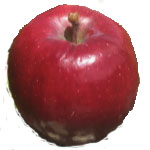 William's Pride
William's Pride
- A cross of Jonathan x Melba x Mollie's Delicious, Rome found in 1975 in West Lafayette, Indiana, by the Indiana, New Jersey, and Illinois (PRI) joint apple-breeding program, and released commercially in 1988
- early-maturing, early July, the very earliest known commercial red apple in the Midwestern United States. It ripens 1 week after 'Lodi' and 7.5 to 8 weeks before 'Delicious'.
- very attractive entirely dark red/purple apple, medium to large in size, slightly conical, .
- Slightly tart, with complex sweet and rich flavor
- attractive, dark red apple
 Winesap
Winesap
- Rich red color with white or yellowish flesh
- Crisp texture and juicy
- Sweet, tangy flavor
- Best for cooking
- Winesap is an old apple cultivar of unknown origin, dating at least to American colonial times.
- all-purpose, being used for fresh eating, cider, apple butter, and pies.
- late season.
 Yates
Yates
- Mid to late season
- Rich red color with white flesh
- Sweet
- Best for eating
- Late season
- Small
 York
York
- Crisp and flavorful
- "lop-sided" shape
- Deep red with green streaks
- Best for eating. holds texture during cooking and freezing
 Zestar
Zestar
- Sweet-Tart
Best for Fresh Eating and Cooking - Early-Mid season
Tart or Sweet?
Check the chart below for a comparison
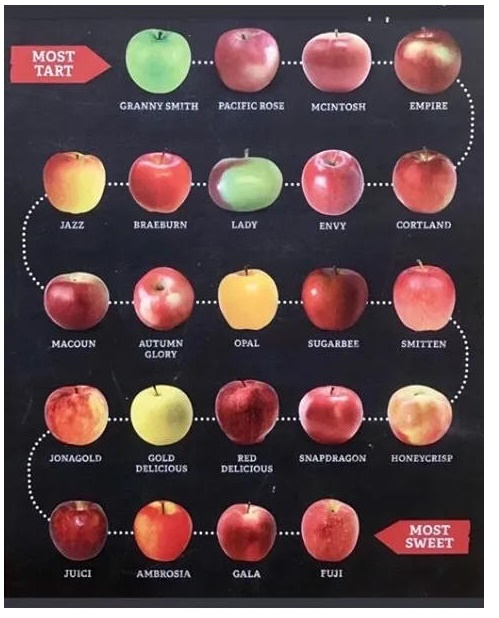
Images from the U.S. Apple Association (mostly)!
English Apple Varieties
These links take you to photos on GardenAction.co.uk
- Bramley - The English gush over this apple with a fever (fevour?:) that borders on mania. It's basically a granny smith type, a higher acid content and lower sugar apple, with a stronger, more tangy taste. Bramley's are considered to be an ideal cooking apple.
- Charles Ross
- Crispin
- Early Victoria
- Early Worcester
- Ellisons Orange
- Epicure
- Gibsons Scarlet
- Golden Spire
- Greensleaves
- Howgate Wonder
- Ingrid Marie
- James Grieve
- Jonagored
- Jupiter
- Katy
- Orleans Reinette
- Peasgood Nonsuch
- Red Gravenstein
- Red Victoria
- Rev W. Wilks
- Ribston Pippin
- Rosemary Russett
- Spartan
- Sturmer Pippin
- Sunset
- Superb
- Tydermans Late Orange
- Warners King
- Winston
More about apple varieties can be found:
University of Illinois Apple page
Apple photos and brief descriptions
Credits:
photos:
Jonamac, Macoun, PaulaRed: Courtesy of New York Apple Association, © New York
Apple Association
And if you are looking for shipping containers for apples and other fruit, see this page.
Canning Books, Supplies and Accessories
These are my favorite essential canning tools, books and supplies. I've been using many of these for over 50 years of canning! The ones below on this page are just the sampling of. my preferred tools. but you can find much more detailed and extensive selections on the pages that are linked below.
- Strainers, pit removers, seed-skin-stem removers, jelly strainers, etc. All types, makes and prices (from $19 to $350)
- Selecting a KitchenAid mixer and attachments for home canning
- Vacuum Foodsealers for freezing, dried foods, and refrigerated foods - the FoodSaver line
- Cherry pitters reviews, prices and ordering
- Steam Juicers
- Food dehydrators - easy and fast to dry your own fruits, veggies, sun-dried tomatoes, etc.
The All New Ball Book Of Canning And Preserving: Over 350 of the Best Canned, Jammed, Pickled, and Preserved Recipes Paperback
This is THE book on canning! My grandmother used this book when I was a child.; It tells you in simple instructions how to can almost anything; complete with recipes for jam, jellies, pickles, sauces, canning vegetables, meats, etc.
If it can be canned, this book likely tells you how! Click on the link below for more information and / or to buy (no obligation to buy)The New Ball Blue Book of Canning and Preserving
Canning and Preserving for Dummies by Karen Ward
This is another popular canning book. Click here for more information, reviews, prices for Canning and Preserving For Dummies
Of course, you do not need to buy ANY canning book as I have about 500 canning, freezing, dehydrating and more recipes all online for free, just see Easy Home Canning Directions.
Home Canning Kits
See here for related tools, equipment, supplies on Amazon See here for related tools, equipment, supplies on Amazon
I have several canners, and my favorite is the stainless steel one at right. It is easy to clean and seems like it will last forever. Mine is 10 years old and looks like new.
The black ones are the same type of standard canner that my grandmother used to make everything from applesauce to jams and jellies to tomato and spaghetti sauce.
This complete kit includes everything you need and lasts for years: the canner, jar rack, Jar grabber tongs, lid lifting wand, a plastic funnel, labels, bubble freer, It's much cheaper than buying the items separately. It's only missing the bible of canning, the Ball Blue Book.
You will never need anything else except jars & lids (and the jars are reusable)!
The complete list of canners is on these pages:
- Water bath canners - Good for acidic foods, like applesauce, pickles, salsa, jams, jellies, most fruits
- Pressure canners - needed for low and non-acidic foods, like canned vegetables (corn, green beans, etc), and meats
- Canners for glass top stoves if you have a glass or ceramic stove
- Canners for induction stovetops
Pressure Canners
If you plan on canning non-acidic foods and low acid foods that are not pickled - this means: meats, seafood, soups, green beans corn, most vegetables, etc., then you ABSOLUTELY must use a Pressure Canner.
Of course, you can use a pressure canner as a water bath canner as well - just don't seal it up, so it does not pressurize. This means a Pressure Canner is a 2-in-1 device. With it, you can can almost ANYTHING.
There are also other supplies, accessories, tools and more canners, of different styles, makes and prices, click here!
Basic Canning Accessories
From left to right:
- Jar lifting tongs to pick up hot jars
- Lid lifter - to remove lids from the pot of boiling water (sterilizing )
- Lids- disposable - you may only use them once
- Ring - holds the lids on the jar until after the jars cool - then you remove them, save them and reuse them
- Canning Jar funnel - to fill the jars
Strainers
These are very useful for making sauces like applesauce, tomato sauce, spaghetti sauce, jellies, etc. Below are my favorites. The complete list is on these pages:
- Strainers, pit removers, seed-skin-stem removers, jelly strainers, etc. All types, makes and prices (from $19 to $350)
- Selecting a KitchenAid mixer and attachments for home canning
Inexpensive Old School Strainers: hand cranked Foley Food Mills
- The hand-cranked Foley food mill (see this page or clock the ad box) has been used for well over 100 years in homes all over America (and variants around the world). It is effective and inexpensive, and ideal for small batches. However, if you need to make many quarts, you will sure end up with tunnel carpel syndrome or some other repetitive strain injury.
Norpro 1951 Manual Food Strainer and other brand stariners, with optional motors; (almost identical to Victorio V250, Villaware and Roma models, all discontinued)
This is The next step up from the Foley food mill. First, it's far more ergonomic, and its handle is easier to use. Next, it works in continuous mode rather than batch mode. So you can do much larger volumes easily. Finally, It has an optional motor, so you can. remove the manual labor. It also offers many different size strainers to use for different types of berries, vegetables and fruit.
See the seller's website for more information, features, pricing and user reviews!
- A Johnny, Weston or Oxo strainer (about $60 - $100, see further down the page) or
- This trainer is. simply a more upscale and improved version of the one above.
- See this page for more information, reviews, descriptions of other strainers and supplies or to order!
KitchenAid - Best Large Volume Strainers
If you're going to do large volumes of fruit or vegetables , or do it year after year, then. you really should think about getting a higher end kitchen. utility device. Kitchen aids are the cream of the crop. Once you buy one of these, you keep at the rest of your life and it gets handed down to the next generation. . My sister is using one she inherited from my mother 25 years ago, who got it in the 1940s as a wedding gift. So, although the initial cost is high, they literally last for many lifetime. So the cost on an annual basis is pretty trivial, especially when you consider the cost of therapy and treatment for. the repetitive strain injuries you will get from manual cranking day after day. Add to that of course the cost of therapy for the emotional injuries you'll get from going insane, standing there hand cranking something for hours.
KitchenAid's with a sieve/grinder (with the attachments, costs about $400, but it lasts a lifetime and is fast and easy to use - I can make 100 quart jars of applesauce per day with one of these).
FREE Illustrated Canning, Freezing, Jam Instructions and Recipes
Don't spend money on books. that you don't need to. Almost everything you can find in some book sold online or in a store is on my website here for free. Start with theEasy Home Canning Directions below. That is a master list of canning directions which are all based upon the Ball Bblue book, the National Center for Home Food Preservation and other reputable lab tested recipes. Almost every recipe I present in addition to being lab tested com. is in a step by step format with photos for each step and complete. explanations. that tell you how to do it, where to get the supplies and pretty much everything you need to know. In addition, there almost always in a PDF format so you can print them out and use them while you cook.
[ Easy Home Canning Directions]
[FAQs - Answers to common questions and problems]
[Recommended books about home canning, jam making, drying and preserving!]
Looking for canning equipment and supplies?
Water bath canner with a jar rack
Pressure canners for gas, electric and induction stoves: Presto 23Qt or T-fal 22Qt
Canning scoop (this one is PERFECT)
Ball Blue book (most recent version)
Jars: 8oz canning jars for jams
Find Other types of farms:
Farm markets and roadside stands
Road trips and camping resources
Local Honey, apiaries, beekeepers
Consumer fraud and scams information
Home canning supplies at the best prices on the internet!
Maple Syrup Farms, sugarworks, maple syrup festivals
Environmental information and resources
Farms For Your Event for birthday parties, weddings, receptions, business meetings, retreats, etc.
Festivals - local fruit and vegetable festivals
Get the
most recent version of
the Ball Blue Book
With this Presto 23 quart pressure canner and pressure cooker, you can "can" everything, fruits, vegetables, jams, jellies, salsa, applesauce, pickles, even meats, soups, stews. Model 01781

You can make jams, jellies, can fruit, applesauce, salsa and pickles with water bath canners, like this Granite Ware 12-Piece Canner Kit, Jar Rack, Blancher, Colander and 5 piece Canning Tool Set



